Sanitation photo gallery
melliott2Sanitation for nurseries










Back to Managing Phytophthora diseases in the nursery










Back to Managing Phytophthora diseases in the nursery
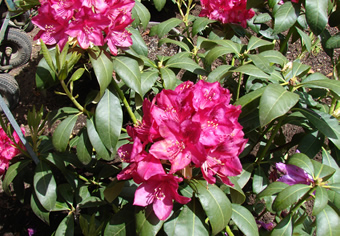
Rita L. Hummel, Marianne Elliott, Gary Chastagner, Robert E. Riley, Kathy Riley, and Annie DeBauw, Washington State University, Puyallup Research and Extension Center, 2606 W. Pioneer, Puyallup, WA 98371; klriley@wsu.edu
Research information demonstrating the effects of various cultural practices on host susceptibility to Phytophthora ramorum is generally lacking and thus limits the development of an integrated approach to managing diseases caused by this pathogen in irrigated nursery systems. Rhododendron spp. have accounted for about 78% of the plants associated with P. ramorum-positive nursery finds in Washington State. Nitrogen fertility levels have been reported to influence disease in some Phytophthora disease pathosystems, but data is not available for the P. ramorum-rhododendron pathosystem.
During 2008 we investigated the dynamics between nitrogen application rates and the susceptibility of ‘English Roseum’, ‘Cunningham’s White’ and ‘Compact P.J.M.’ to P. ramorum. One-gallon plants were potted into 3-gallon containers. The growing medium was 100% Douglas-fir bark with micromax incorporated at the rate of 1.75 lbs/yd3. Plants were placed on a gravel nursery bed and watered as needed with overhead sprinkler irrigation. Residual fertilizer in the media was depleted, then ammonium nitrate fertilizer at 100, 300 and 600 ppm N was applied in liquid form twice a week to each of eight plants per cultivar starting on June 2nd. The same rate of P (potassium phosphate) and K (potassium sulfate), 100 and 200 ppm, respectively, was applied at each fertilization. Commencing with fertilizer application, the plants were switched to a drip irrigation system. In early October, plant growth, visual quality and leaf color were measured. At the same time, fully mature, current season leaves from each plant were harvested for determination of leaf tissue nitrogen content and P. ramorum inoculations.
Six detached leaves from each plant were inoculated with suspensions of zoospores from an NA1 lineage rhododendron isolate of P. ramorum by pipetting a 10 ul drop of suspension onto the lower leaf surface. The leaf tissue beneath drops on three leaves was injured using an insect pin, while the tissue beneath each drop on the other leaves was left unwounded. The leaves were then incubated at 19-20 C.
As expected, shoot growth and plant quality indices increased with nitrogen fertility. Based on an overall analysis of lesion size after 10 days, there was a significant difference in the susceptibility of the three cultivars to P. ramorum. “Compact P.J.M.’ had the smallest lesions, while ‘English Roseum’ had the largest. Lesions developed on all the wounded and unwounded inoculation sites on the ‘English Roseum’ and lesion size increased with increasing nitrogen fertility. Nitrogen fertility had no effect on lesion size on the other two cultivars.
in
Proceedings of the Sudden Oak Death Fourth Science Symposium 2010
Susan J. Frankel, John T. Kliejunas, and Katharine M. Palmieri, tech. coords.
Gen. Tech. Rep. PSW-GTR-229. Albany, CA: U.S. Department of Agriculture, Forest Service, Pacific Southwest Research Station. 378 p
| Abstract pdf | Poster pdf |
Adapted from USDA National PRED Program for WSU Extension
Objective: To provide training on how to recognize symptoms potentially caused by Phytophthora ramorum and how to screen samples to determine if they should be submitted to the WSU Puyallup Plant and Insect Diagnostic Laboratory for P. ramorum testing.
Background: Sudden Oak Death (SOD) and Ramorum Blight are plant diseases caused by the fungal-like organism P. ramorum. This USDA-APHIS regulated pathogen was first identified in 2000 after killing thousands of tan oaks in California and causing a leaf blight on rhododendrons in Europe. Since then it has been found to infect many plants common to Washington’s natural and ornamental landscapes, including rhododendron, viburnum, big leaf maple, madrone, grand fir, and Douglas-fir. P. ramorum has spread to the natural landscape in 14 coastal counties in California, and one county in southwestern Oregon. Since 2003 this pathogen has been detected in western Washington nurseries and was first detected in a stream in 2006. The Washington State Department of Agriculture, in cooperation with the United States Department of Agriculture, is monitoring Washington’s nurseries and implementing eradication efforts to keep this pathogen from spreading to the natural environment or landscapes. This program has been designed to train Master Gardeners and WSU Extension affiliates as first detectors of P. ramorum, in the event that this organism is introduced into Washington’s landscape. Information provided will also be applicable to diagnosis and detection of other plant pathogens.
Program outline
1) Background and history of P. ramorum
2) Current status of P. ramorum in Washington
3) Introduction to WSU Sudden Oak Death Education program
4) Recognizing potential symptoms and determining if samples should be submitted for P. ramorum testing
Funding for this outreach has been provided by the USDA Forest Service, Pacific Southwest Region, Forest Health Protection
For information, please contact:
Marianne Elliott
Puyallup Research and Extension Center
2606 W. Pioneer
Puyallup, WA 98371-4998
253-445-4596
melliott2@wsu.edu
Effect of Surface Sterilization Treatments on the Detection and Viability of Phytophthora ramorum on Various Substrates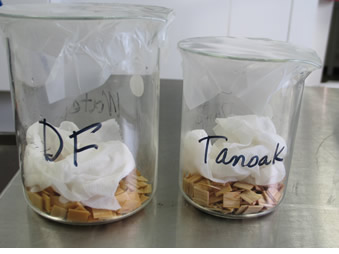
Katie Coats, Kathy Riley, Gary Chastagner and Marianne Elliott, Washington State University, Puyallup Research and Extension Center, 2606 W. Pioneer, Puyallup, WA 98371; kpcoats@wsu.edu
An accurate evaluation of asymptomatic colonization of plant tissue by Phytophthora ramorum requires the ability to distinguish between the surface contamination or epiphytic growth of the pathogen and the colonization of plant tissues. Growth on selective media, such as CARP, following the surface sterilization of plant tissue is often used to confirm P. ramorum colonization of the tissue. The use of PCR to detect asymptomatic colonization of tissues requires that treatments kill pathogen propagules as well as render residual pathogen DNA on the surface of substrates undetectable. A series of surface sterilization tests were performed with two commonly used laboratory surface sterilants to determine their efficacy in killing epiphytic propagules of P. ramorum and rendering pathogen DNA undetectable in several different P. ramorum experimental scenarios. Substrates tested include detached rhododendron leaves, rhododendron leaf discs, and freshly harvested Douglas-fir wood. Whatman filter paper was included to represent an inert surface.
Results from preliminary tests indicate that the efficacy of a treatment varies by experimental scenario and detection method. Based on post-sterilization growth on CARP media, a 30-second treatment in a 10% solution of household bleach (0.6% sodium hypochlorite) one hour after a spore suspension of P. ramorum was applied to rhododendron leaves and leaf discs was as effective as higher concentrations of bleach and longer treatments in bleach in killing the pathogen on the surface of this host. When spore suspensions were placed on Douglas-fir wood samples, a 30-second treatment in a 10% solution of bleach was not as effective as a 30-second treatment with 95% ethanol, based on CARP isolation data post-treatment. When spore suspensions were placed on Whatman filter paper and incubated for 2 days, a 10% bleach solution, 95% ethanol, and water each appeared equally as effective in preventing the detection of P. ramorum by isolation on CARP media post-treatment. When post-treatment quantitative PCR was used to detect the pathogen on Whatman filter paper and Douglas-fir, 10% bleach effectively removed DNA evidence of the pathogen while 95% ethanol and water were ineffective, leaving behind DNA at quantities comparable to those on non-treated substrates.
Additional studies are in progress and will be presented at the symposium.
in
Proceedings of the Sudden Oak Death Fourth Science Symposium 2010
Susan J. Frankel, John T. Kliejunas, and Katharine M. Palmieri, tech. coords.
Gen. Tech. Rep. PSW-GTR-229. Albany, CA: U.S. Department of Agriculture, Forest Service, Pacific Southwest Research Station. 378 p
| Abstract pdf | Poster pdf |
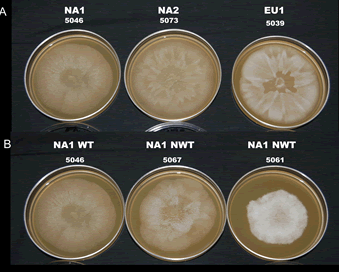
M. Elliott, Washington State University, Puyallup Research and Extension Center, Puyallup, WA, USA 98371; melliott2@wsu.edu ; G. Sumampong, S. F. Shamoun, E. Becker, Canadian Forest Service, Pacific Forestry Centre, Victoria, BC, Canada V8Z 1M5; A. Varga, D. James, S. Masri, Sidney Laboratory, Canadian Food Inspection Agency, Sidney, BC, Canada V8L 1H3; and N. J. Grünwald, Horticultural Crops Research Laboratory, USDA ARS, Corvallis, OR, USA 97330
In earlier studies unusual culture morphology and behavior were noticed among some NA1 isolates of Phytophthora ramorum. This “non-wild type” behavior was not observed in our collection of isolates from the EU1 or NA2 lineages, even though the isolates had been in culture for a similar amount of time. It has been suggested that subculturing in vitro cause culture instability and loss of virulence, and passage through the host can revive the isolate back to its original state. To study this, we compared four less virulent isolates (non-wild type; nwt) with four isolates of normal virulence (wild type; wt) in our culture collection. One objective of this study was to determine whether wt behavior could be restored to nwt isolates of P. ramorum by successive re-isolation from host material. Detached leaves of rhododendron “Cunningham’s White” were inoculated with each of the isolates, which were re-isolated and tested for pathogenic aggressiveness, growth rate at maximum, optimum, and minimum temperatures, and chlamydospore production in vitro.
In both wt and nwt groups, there were significant differences in lesion size on detached rhododendron leaves between the original culture and the first re-isolation. Successive re-isolations were not different from the original culture and the first re-isolation. After re-isolation from the host, nwt isolates were still less aggressive than wt isolates. Along with lower aggressiveness on rhododendron leaves, nwt isolates produced fewer chlamydospores in V8 agar than did wt isolates. There was no difference in growth rate between the original culture and the first re-isolation for most isolates. However, nwt isolates were found to be more sensitive to temperatures below 2°C and above 28°C. The optimum growth temperature was 20°C.
Our preliminary results show that non-wild type isolates were more variable than wild type isolates in all of the characters tested, and were generally lower in aggressiveness, chlamydospore production, and growth rate at all temperatures for both the original culture and when re-isolated from a host. The greater variability suggests that these isolates are unstable or that slightly deleterious mutation(s) have accumulated in accordance with Muller’s ratchet resulting in reduced fitness. Wild type isolates performed better than non-wild type isolates in all of the phenotypic characters examined. Why nwt survives and proliferates is still a mystery. To understand the cause of these phenotypic differences, the role of cytoplasmic elements and differences in mitochondrial and nuclear DNA are being examined.
in
Proceedings of the Sudden Oak Death Fourth Science Symposium 2010
Susan J. Frankel, John T. Kliejunas, and Katharine M. Palmieri, tech. coords.
Gen. Tech. Rep. PSW-GTR-229. Albany, CA: U.S. Department of Agriculture, Forest Service, Pacific Southwest Research Station. 378 p
| Abstract pdf | Poster pdf |
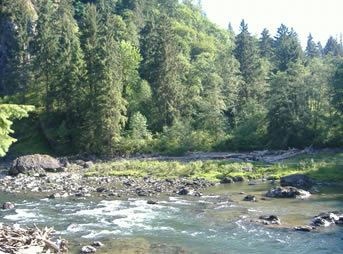
Spread of Phytophthora ramorum to water, soil, and vegetation outside a nursery in Pierce County, Washington
G. CHASTAGNER (1), K. Coats (1), M. Elliott (1)
(1) Washington State University, Puyallup, WA, U.S.A.
Phytopathology 101:S32
Volunteer stream monitoring for invasive Phytophthora species in western Washington
M. ELLIOTT (1), G. Chastagner (1), K. P. Coats (1), A. DeBauw (1), K. Riley (1)
(1) Washington State University, Puyallup Research and Extension Center, Puyallup, WA, U.S.A.
Phytopathology 101:S48
Mystery on the Sammamish: What are the sources of Phytophthora ramorum infesting this Washington State waterway?
G. Chastagner (1), K. COATS (1), D. Omdal (2), A. Ramsey-Kroll (2), M. Elliott (3)
(1) Washington State University, Puyallup, WA, U.S.A.; (2) Washington State Department of Natural Resources, Olympia, WA, U.S.A.; (3) Washington State University, Puyallup Research and Extension Center, Puyallup, WA, U.S.A.
Phytopathology 101:S32
Presentations and workshops are available on a variety of topics related to Sudden Oak Death. Presentations can be downloaded for viewing or contact Marianne Elliott (melliott2@wsu.edu) to arrange a presentation or workshop for your group.
SOD Symptom ID and Nursery ManagementA presentation for nursery professionals on recognizing symptoms of P. ramorum on nursery crops and best management practices to minimize the impact of P. ramorum on a nursery. |
 |
Life Cycle of P. ramorum as it Relates to Soil and WaterLearn how P. ramorum survives and spreads in soil and water environments. Best management practices for nurseries are also discussed. |
 |
Sudden Oak Death and Other Phytophthora Diseases of RhododendronRhododendron is the most important host of P. ramorum in Washington nurseries. Learn how to recognize symptoms of P. ramorum and other Phytophthora diseases of Rhododendron. Some results of a study screening a large number of Rhododendron species and cultivars are also presented. |
 |
Sudden Oak Death, Madrone Canker, and Systemic Acquired ResistanceA not so random grouping of subjects that will interest tree care professionals and others. |
 |
“What’s killing my tree?”A presentation from the Master Gardener Advanced Education Conference, Sept 22-24 2011, Ocean Shores, WA. Includes information about tree diseases with special sections on SOD and madrone blight. PDF, ~10 MB. |
Sudden Oak Death First Detector workshops are available for interested groups and industry professionals. The purpose of these workshops is to train participants as first detectors, in the event that P. ramorum is introduced to Washington’s landscape. Master Gardener volunteers and horticultural and natural resource professionals are encouraged to attend a training session.
Managing Phytophthora diseases in the nurseryPhytophthora diseases are very costly to nurseries, and a positive P. ramorum find can have huge economic consequences. At this hands-on workshop methods for reducing damage by Phytophthora diseases in the nursery will be demonstrated. |
 |
For information, please contact:
Marianne Elliott
Puyallup Research and Extension Center
2606 W. Pioneer
Puyallup, WA 98371-4998
253-445-4596
melliott2@wsu.edu
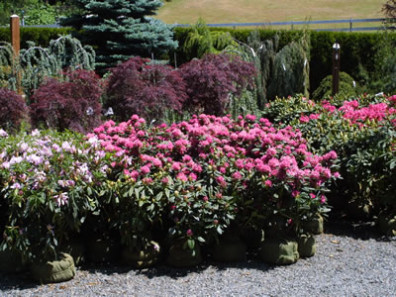 The American Public Gardens Association (APGA) is working with the National Plant Diagnostic Network to develop a Sentinel Plant Network, under a grant funded by USDA-APHIS under the 2008 Farm Bill.
The American Public Gardens Association (APGA) is working with the National Plant Diagnostic Network to develop a Sentinel Plant Network, under a grant funded by USDA-APHIS under the 2008 Farm Bill.
APGA recently launched a SPN web page that provides an overview of the program, and its mission, the benefits of participation and information on how member gardens can get involved.
APGA has been working closely with NPDN to develop two “train-the-trainer” modules for public gardens. The first module addresses the impact of plant pests and pathogens and the importance of early detectors as well as providing an overview of the SPN, its primary partners, and the role of participating gardens. The second module, which is focused on the “best practices” of pest /pathogen scouting and reporting and outlines the proper methods of sample collection and submission, will provide valuable instruction to public garden professionals and volunteers. Gardens participating in SPN will be encouraged to use this module in classes offered to the general public, thereby giving them the necessary training to be effective citizen scientists contributing to the early detection of potential threats. Preliminary versions of these modules are expected prior to APGA’s conference in June and will undergo beta testing over the summer before being integrated into the SPN regional professional development workshops this fall and winter.
APGA is also developing a freestanding website marketed towards kids and educators and will work with a curriculum specialist to develop a teacher / parent guide to these resources.
 For her senior project, a student at Bellarmine High School, Tacoma, is testing several isolates of Phytophthora and Pythium spp. to determine whether they cause disease on Noble fir seedlings. Noble fir (Abies procera) is commonly grown as a Christmas tree in western Washington and some growers irrigate using local stream water. Some of the test organisms have been collected from streams in western WA in the 2011 stream monitoring program. Others are known pathogens of Noble fir and are included as standards or to obtain more information about their behavior on roots.
For her senior project, a student at Bellarmine High School, Tacoma, is testing several isolates of Phytophthora and Pythium spp. to determine whether they cause disease on Noble fir seedlings. Noble fir (Abies procera) is commonly grown as a Christmas tree in western Washington and some growers irrigate using local stream water. Some of the test organisms have been collected from streams in western WA in the 2011 stream monitoring program. Others are known pathogens of Noble fir and are included as standards or to obtain more information about their behavior on roots.
Test organisms will be selected from this list:
| Sample # | Isolate # | Species | Origin |
|
1 |
1106-BP1-L2A | Pythium undulatum* | Stream bait, North Crk, Snohomish Co. |
|
2 |
1106-BP1-L4B | Phytophthora taxon “PGchlamydo”* | Stream bait, North Crk, Snohomish Co. |
|
3 |
109-0045 | Phytophthora cryptogea* | Noble fir roots, Puyallup, WA |
|
4 |
109-0038 | Phytophthora gonapodyides* | Noble fir roots, Puyallup, WA |
|
5 |
1106-BP1-L3B | Phytophthora taxon ‘salixsoil’* | Stream bait, North Crk, Snohomish Co. |
|
6 |
109-0049 | Phytophthora cambivora | Noble fir roots, Puyallup, WA |
|
7 |
P720 | Phytophthora cinnamomi* | Pacific madrone roots, CA |
|
8 |
1105-BP1-L3A | Pythium sp. #1* | Stream bait, Goldsborough Crk, Mason Co. |
|
9 |
109-0030 | Phytophthora citricola | Noble fir roots, Puyallup, WA |
|
10 |
109-0055 | Phytophthora megasperma* | Noble fir roots, Puyallup, WA |
|
11 |
1112-BP2-L2B | Pythium anandrum* | Stream bait, Wollochet Crk, Pierce Co. |
|
12 |
1112-BP1-L2B | Phytophthora inundata* | Stream bait, Wollochet Crk, Pierce Co. |
|
13 |
1102-BP1-L5B | Pythium grandisporangium | Stream bait, Clarks Crk, Pierce Co. |
|
14
|
1103-BP3-L4A | Phytophthora taxon “oaksoil”* | Stream bait, Clarks Crk, Pierce Co. |
*Used in Trial 1
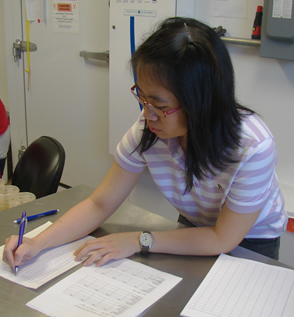 Now you have data, what to do with it?
Now you have data, what to do with it?
This manual provides good information about designing experiments, data exploration, and statistical tests. You will need Microsoft Excel and the data analysis tool pack installed.
How to write a scientific article – each journal will have its own format, but the basic ingredients can be found at this link: